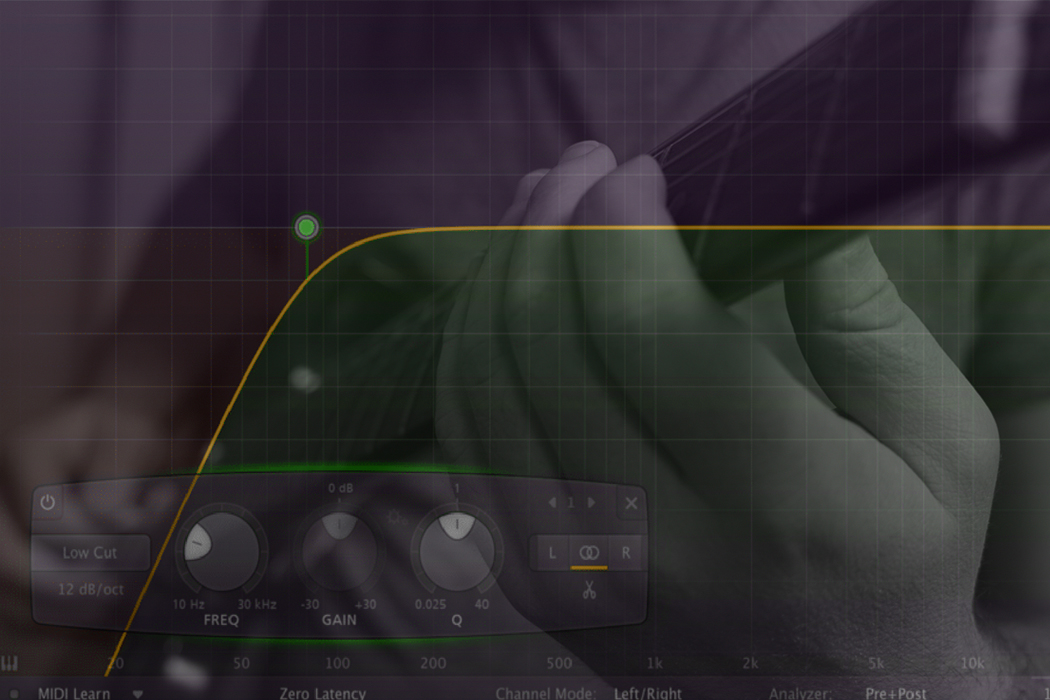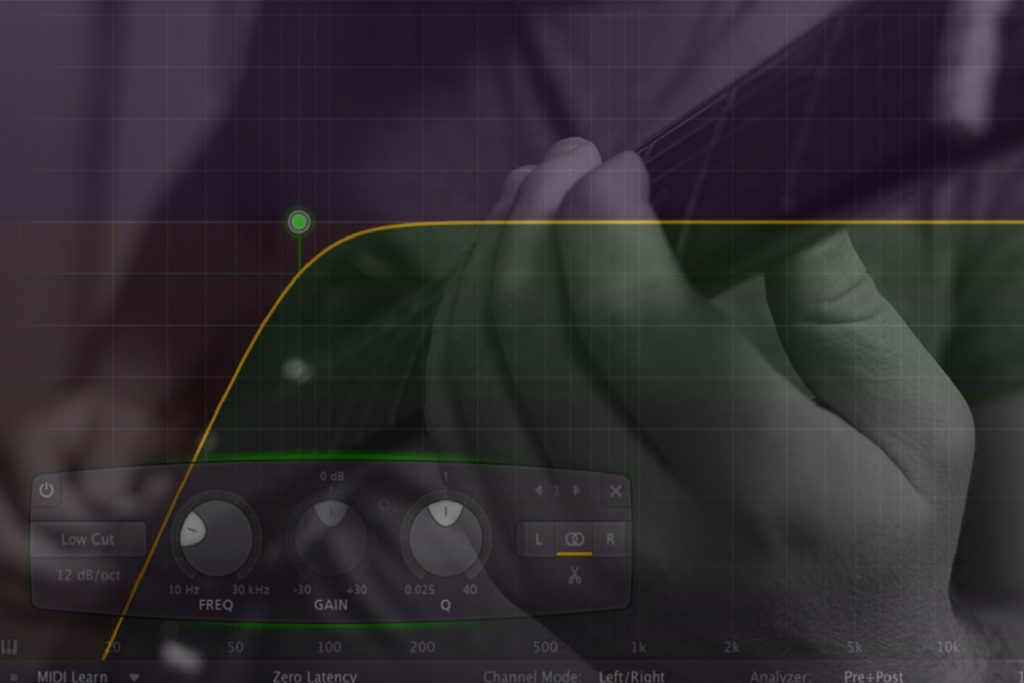
+ Learning to record and mix at home? Soundfly’s online courses on mixing, producing, and beat making can help! Preview them all for free and subscribe for full access.
Guitarists are in a unique situation — they play an instrument that comes in two wildly different and distinct flavors. When it comes to audio engineering, the treatment of acoustic guitars is at times a night and day difference from that of an electric guitar played through an amp, let alone all the various types of acoustic body shapes and string types.
So, from a mixing standpoint, it’s a good idea to go over equalization for these very different beasts, even if they may have been played by the same person! And first, if you’re new to EQ, here’s a primer video taken from Soundfly’s Faders Up: Modern Mix Techniques course, exploring how some professional engineers use it on a daily basis.
1. Consider the Context
Before you EQ anything, always consider the context. Is the instrument part of a big mix? What kind of music is it inside? Is it super distorted? Should the guitar sound mean or clean? Is it the main focal point or just a supporting actor?
When it comes to acoustic versus electric guitars, obviously acoustics are more often left alone in a sparse mix, or part of a cleaner, more intimate sound. This isn’t to say acoustic guitars don’t end up in big loud rock mixes, but it’s more likely that they’ll need to sound natural.
In contrast, electric guitars are often intended to be big, loud, and boisterous, sometimes distorted. So, when it comes to EQ, you’ve got more room for harsh moves if the context is dirty. For that reason, boosting EQ may be more desirable, and you may want to cut a lot more out if the instrument is part of a big mix.
2. Low End
One thing electric and acoustic guitars have in common is they almost always need a pretty significant high pass cut. If an electric guitar is part of a rock mix, you may end up high pass filtering as high as 250 Hz to make room for the bass. Similar for acoustic guitars in a mix.
When all alone, you’ll want an acoustic guitar to fill more of the space, so you might not want such a severe low end cut. Still, you may want to roll off as high as 80-100 Hz, depending on the presence of a singer and what their voice is like.
Try this: Listen to the results as you sweep the HPF up from 20 Hz. When you start to hear a noticeable difference, stop and back off a bit.
For both kinds of guitars, if you’re not filtering out frequencies above 80 Hz, you’ll want to look for boom — acoustics are more likely to be too boomy around 100 Hz, and you may want to look for resonances at 200 Hz and 400 Hz (or thereabouts).
Distorted electrics will vary wildly, but some distorted guitar tracks have way too much information around 200-300 Hz. Take a listen and sweep both with extreme boost and extreme cuts to find the place where you want to trim the fat.
+ Read more on Flypaper: “8 Tips for Mixing an Entire Album so It Sounds Consistent.”
3. Further Cutting
Continuing with your initial subtractive EQ, you’ll want to look for mud next. Mud occurs from anywhere around 200-800 Hz, but can be especially bad from 300-600 Hz. Use your sweeping technique to find the ugly spots and their resonant counterparts.
Acoustics can get too fat around 250 Hz and electrics may have too much honk at 800 Hz or so; in either case, listen for ugliness and sweep until you find the cut points. 400 Hz is a center point for a kind of boxy, disgusting, cardboard disappointment; so as a rule of thumb, check that area to see if you can clean things up.
4. To Boost or Not to Boost?
Many mixers never boost, but instead only cut EQ, and there’s a good argument for that. However you may want to add a little here and there, especially with electrics.
You can emphasize the squeal or the high-mid bite on an electric guitar by trying some boosts around 3,000-5,000 Hz, or even higher. Try 1k for another potential sweet spot. If you can find the range where the distortion is mean, cuts through, and gives you want you want, you can boost that a little and turn the rest of the track up, effectively cleaning out a lot of other un-useful frequencies.
Watch out though: the main active range of an electric guitar is often the same exact range of frequencies needed to hear a singer’s lyrics — especially with a male tenor. Pay close attention to the interaction between the vocals and the guitar as you boost — make sure you don’t lose the lyric.
Acoustics usually call for less boosting, especially when they’re alone in the mix. In that case, you want as natural a sound as possible, so boosting to aggressively is likely to hurt your cause. Still, a nice high shelf starting at around 8,000 Hz may help add a little shimmer and air to your track.
If an acoustic sits in a bigger mix and you want it jangly, look for boosts in the 5-8,000 Hz range (loosely). You may be able to apply the strategy mentioned above to effectively turn down a lot in favor of the specific piece you want to emphasize.
5. EQ Is EQ
We’ve talked briefly here about the difference between acoustic and electric guitars when EQing, but if you want to know a secret, well, EQ is EQ. The best strategy for any instrument is to first know the context, understand its overall goal, and use strategic listening and sweeping to quickly find the bad spots and clean them up.
Just remember that the more organic an instrument is — as in a lone acoustic guitar — the softer your touch should be, especially with boosting. By contrast, a super aggressive electric guitar could benefit from some more extreme measures. Just be sure to listen to the results in the context of your whole mix.
You’ll have a much easier time EQing a track that’s been well-recorded (especially when it comes to acoustics). So start with a great room and a great performance to make EQ a snap.
Continue learning with hundreds more lessons on mixing, DIY home audio production, electronic music recording, beat making, and so much more, with Soundfly’s in-depth online courses, like Modern Pop Vocal Production, Advanced Synths & Patch Design, and Faders Up: Modern Mix Techniques (to name a few).





